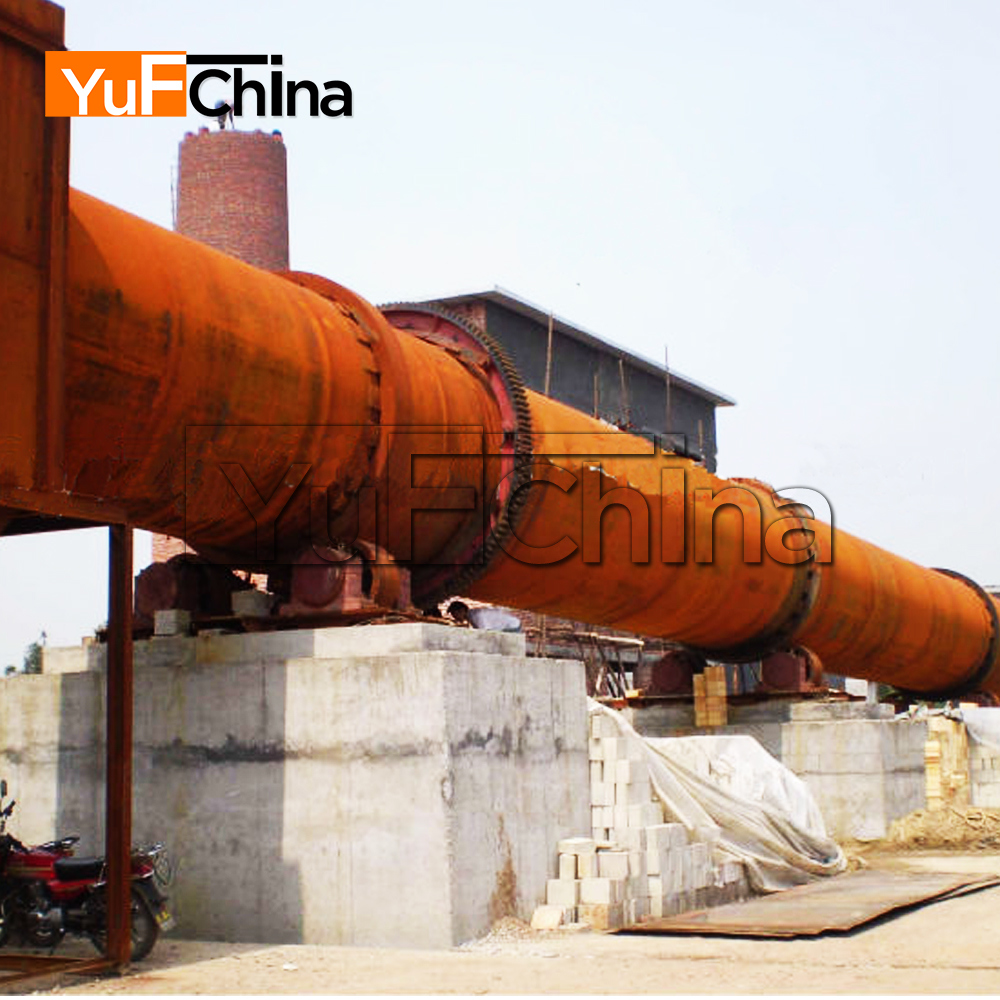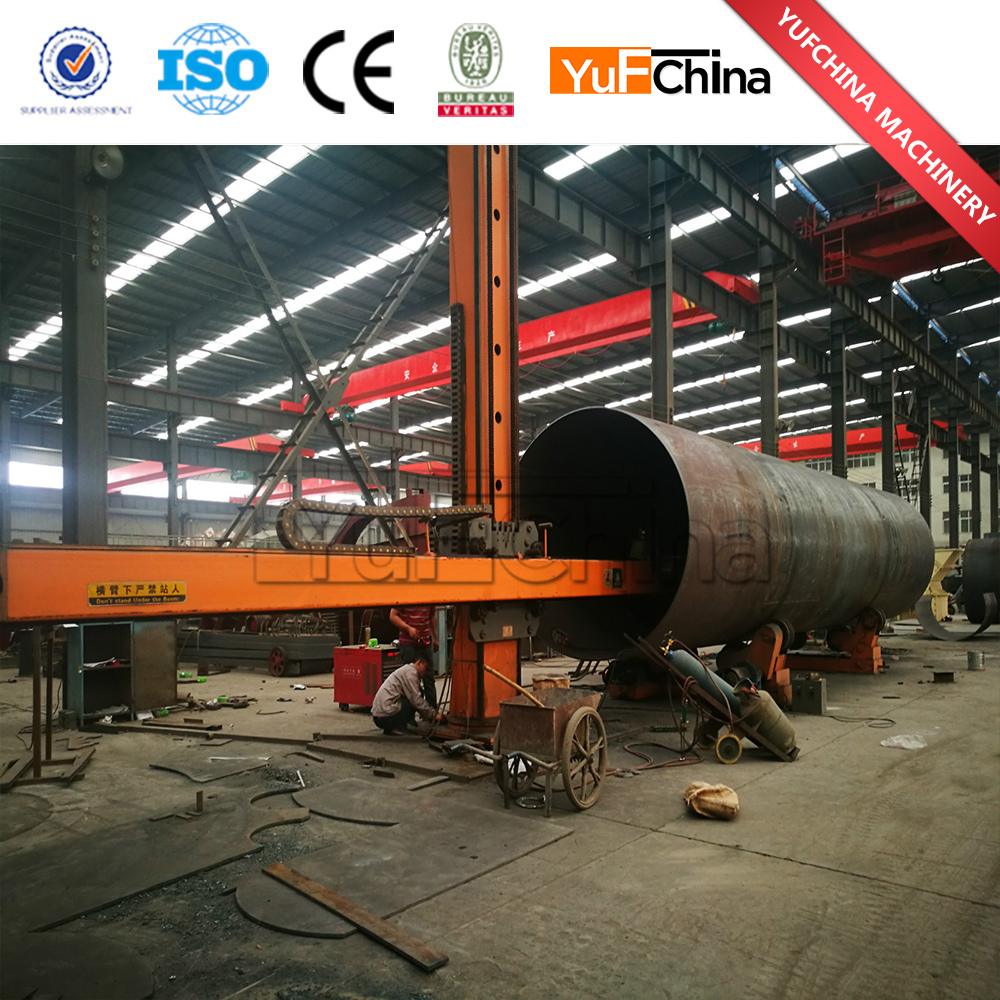Rotary Kiln for Limestone, Cement, Iron Ore
Model NO.: 53t
Energy Saving: Energy Saving
Warranty: 1 Year
Color: Multi Color
Customized: Customized
Condition: New
Mining Object: Metallic and Non-Metallic Ore Excavator
Application: Building Materials, Mineral Processing, Metallurgy
Delivery Time: Within 15 Days
After Sale Service: Engineers Available to Service Machinery Overseas
Trademark: YUFCHINA
Transport Package: Standard Container or in Bulk
Specification: 53t
Origin: Henan, China
HS Code: 84741000
Rotary Kiln for Limestone, Cement, Iron Ore
Â
Rotary kiln is the main equipment used for calcining cement clinker. It finds extensive applications in industries such as cement production, metallurgy, and chemical manufacturing. The rotary kiln consists of several key components including the shell, supporting device, thrust roller, driving mechanism, movable kiln head, sealing system at the tail, and combustion unit. Its simple design ensures reliable operation and easy process control. Â

Structure of Rotary Kiln
1. Support Device: Advanced shaft structure with automatic temperature measurement and electrical heating systems.
2. Catch Wheel: Available in mechanical and hydraulic types.
3. Gears: Single or double, controlled by buncher, DE machine, and frequency variable motor. Reliable, energy-efficient, and efficient.
4. Cylinder Tyre Bolster: Three types—Fixed, Zoom, and Floating. Simple structure, convenient replacement, and no damage to the cylinder.
5. Sealing Equipment: Options include air cylinder edge sealing, spring edge sealing, graphite block sealing, and combinations. Adaptive to cylinder rotation and swing, with excellent sealing performance.
6. Kiln Head Hood: Includes stationary and flexible types.

Working Principle of the Rotary Kiln:
Through technical upgrades, the rotary kiln has adopted advanced technologies such as hydraulic thrust roller devices, high-precision plunger pumps, variable-speed valves, and contact graphite block sealing systems. To enhance automation, industrial TV monitoring is used at the kiln head, simulation phosphor screens display the process flow, and infrared scanning systems monitor the calcining zone directly on a computer. These new technologies provide clear visibility, convenient operation, and reliable use. As a result, thermal conditions are stabilized, and equipment running rates are improved. Compared to similar-sized equipment, the running rate has increased by up to 10%, production has increased by 5–10%, and heat consumption has decreased by 15%.
Rotary kilns belong to building material equipment and can be categorized into cement kilns, metallurgical chemical kilns, and lime kilns based on the materials they process.
Cement kilns are used for producing cement clinker, with both dry and wet methods available. Metallurgical chemical kilns are used for magnetic roasting of iron ore and oxidizing roasting of chrome and nickel in steel plants; baking high-alumina ore in refractory factories; baking chamotte and alumina in aluminum plants; and baking chrome ore and powder in chemical plants.
Lime kilns are used for baking active lime and dolomite in steel and ferroalloy plants.

Warranty for Rotary Kiln:
The product is 100% brand new upon leaving the factory. The seller guarantees the quality of the machines for one year from the completion of trial runs, but not exceeding thirteen months from the date the machines are shipped to the delivery port. If any parts (excluding easily damaged parts) are found defective within the first year, the seller will replace them free of charge. After one year, replacements can be made on a favorable payment basis.
| Serial Number | Specification | Output (t/h) |
Rev(rpm) | Pedestal Number | Reducer | Electricmotor | Power (kw) |
Remark |
| Model | ||||||||
| 1 | 1.6 x 32m | 2 | 0.58-2.85 | 3 | ZQ75-50 | YCT250-4A | 18.5 | Â |
| 2 | 1.6/1.9 x 36m | 2.5-3 | 0.53-1.59 | 3 | ZQ110-7 | YCT250-4B | 22 | Â |
| 3 | 1.9 x 39m | 3-3.4 | 0.53-1.59 | 3 | ZQ125-7 | YCT315-4A | 37 | Â |
| 4 | 2.2 x 45m | 4-5 | 0.214-1.64 | 3 | host ZS125-5 assist ZQ40-40 |
host YCT315-4B assist Y112M-4 |
45 4 |
 |
| 5 | 2.5 x 40m | 6.3 | 0.62-1.5 | 3 | host ZS165-5 assist ZS50-1 |
host YCT355-4A assist Y160M-6 |
55 7.5 |
preheater kiln  |
| 6 | 2.5 x 50m | 5-6 | 0.62-1.5 | 3 | host ZS165-5 assist ZS50-1 |
host YCT355-4A assist Y160M-6 | 55 7.5 |
 |
| 7 | 2.5 x 55m | 5-6 | 0.62-1.5 | 3 | host ZS165-5 assist ZS50-1 |
host YCT355-4A assist Y160M-6 | 55 7.5 |
 |
| 8 | 2.7 x 42m | 13 | 0.6-2.3 | 3 | host ZS145-3-1 assistZL50-16-2 |
host YCT355-4A assist XH195 |
55 11 |
preheater kiln |
| 9 | 2.7 x 44m | 13 | 0.74-2.21 | 3 | host ZSY355-50-1 assist ZSY160-40-2 |
host YCT355-4A XH195 |
55 11 |
preheater kiln |
| 10 | 2.8 x 42m | 14 | 0.5-2.503 | 3 | ZSY355-50-1 assist ZSY160-40-2 |
host Z2-101TH assist Y160M-6 |
55 7.5 |
preheater kiln |
| 11 | 2.8 x 43m | 8.3 | 0.62-1.5 | 3 | host ZS165-6 assist ZS50-1 |
host YCT355-4B assist Y160L-6 |
75 11 |
preheater kiln |
| 12 | 2.8 x 55m | 6-7 | 0.62-1.5 | 3 | host ZS165-6 assist ZS50-1 |
host YCT355-4B Y160L-6 | 75 11 |
 |
| 13 | 3 x 48m | 700 | 0.67-3.76 | 3 | host NZZL130-15-I assist ZL50-10-1 |
host ZSN4-280-091B assist YCT250-4A | 110 18.5 |
outside the kiln |
| 14 | 3.0 x 50m | 9.2 | 0.5-1.5 | 3 | host ZS165-3 assist ZS50-1 |
ZSN4-280-11B assist Y160L-6 |
125 11 |
preheater kiln |
| 15 | 3 x 60m | 7-9 | 0.5-1.5 | 4 | host ZS165-3 assist ZS50-1 |
host ZSN-280-11B assist Y160L-6 | 125 11 |
 |
| 16 | 3 x 88m | 12.5 | 0.444-1.345 | 5 | host  ZS199-5- 5 assist ZL50-8- 2 |
host  ZSN4-280-091B assist Y160L-6 | 110 11 |
wet kiln |
| 17 | 3 x 100m | 11-13.5 | 0.47-1.48 | 5 | host ZSY500-56-AL assist ZL50-14- 2 |
host  ZSN4-250-21B assist Y160M-4 | 90 11 |
wet kiln |
| 18 | 3.2 x 48m | 1000 | 0.788-3.88 | 3 | host NZS995-40VIBL assist NZS352-40IL |
host ZSN-280-11B Y160L-6 | 125 11 |
 |
| 19 | 3.2 x 50m | 12.5 | 0.4-1.5 | 3 | host ZL130-16 assist ZL50-10 |
host ZSN4-280-11B assist Y180L-4 |
125 22 |
preheater kiln |
| 20 | 3.2 x 50m | 1000 | 0.788-3.938 | 3 | host NZS995-28VBR assist ZL50-9-2 |
host ZSN4-280-21B assist Y180L-6 | 160 15 |
outside the kiln |
| 21 | 3.2 x 64m | 8-10 | 0.4-1.5 | 4 | hostZL130-16 ZL50-10 | host ZSN-280-11B Y180L-4 | 190 22 |
 |
| 22 | 3.2 x 118m | 17 | 0.292-1.459 | 6 | host JH500C-SW-71 assist ZL50-8-1 |
host Z4-250-31 assist Y160L-6 |
110 11 |
wet kiln |
| 23 | 3.3 x 50m | 1000 | 0.36-3.57 | 3 | host NZS995-40-V BL assist NZS352-31.5 |
host ZSN4-280-21B assist Y160M-4 | 160 11 |
outside the kiln |
| 24 | 3.3 x 50m | 1000 | 0.36-3.57 | 3 | host ZSY450-40-VI assist ZL50-14-I |
host ZSN4-280-091B assist Y160M-4 | 160 11 |
preheater kiln |
| 25 | 3.3 x 52m | 1000 | 0.67-3.43 | 3 | host NZS995-45V BL assist ZL50-10-I |
ZSN4-280-21B assist Y160L-6(1100) |
160 11(15HP) | outside the kiln |
| 26 | 3.3 x 54m | 25 | 0.92-2.74 | 3 | host NZS995-45VBL assist ZL42.5-10-2 |
host ZSN4-280-11B assist Y160L-6 |
125 11 |
preheater  kiln |
| 27 | 3.5 x 54m | 1500 | 0.55-3.5 | 3 | host ZSY500-40-V assist ZSY180-31.5-2 |
host ZSN4-315-092 Y200L-6 | 220 18.5 |
outside the kiln |
| 28 | 3.5/3 x 60m | 14-16 | 0.39-1.95 | 4 | host JH500C-SW-56 assist ZL50-10-2 |
host YTSP315M2-6 assist Y160L-6 | 110 11 |
cogeneration hollow kiln |
| 29 | 3.5 x 70m | 12-14 | 0.4-1.5 | 4 | host ZSY500-40 assist ZL50-14 |
host ZSN-315-082 assist Y180L-4 | 280 22 |
 |
| 30 | 3.5 x 125m | 21.8 | 0.281-1.406 | 5 | host ZS165-4-1/2 assist ZL50-8-1/2 |
host ZSN4-250-21B assist Y160L-6 | 2 x 90 2 x 11 | wet dual drive |
| 31 | 3.5 x 130m | 22 | 0.439-1.379 | 5 | host ZS165-3-1/2 assist ZL35-14-1/2 |
host Z2-102 assist Y132S-4 | 2 x 90 2 x 5.5 | wet dual drive |
| 32 | 3.5 x 145m | 25 | 0.345-1.379 | 6 | host ZS165-3-1/2 assist ZL35-14-1/2 |
host ZSN4-250-21B assist Y132S-4 | 2 x 90 2 x 5.5 | wet dual drive |
| 33 | 3.6 x 55m | 16.7 | 0.4-1.5 | 3 | host ZSY500-40 assist ZSY180-31.5 |
ZSN-315-072 assist Y180L-4 |
250 22 |
preheater  kiln |
| 34 | 3.6 x 74m | 20.5 | 0.222-1.666 | 4 | host JH560C-SW-90 assist ZL50-17-1 |
host YTSP315M1-4 assist Y160M-4 | 132 11 |
cogeneration hollow kiln |
| 35 | 3.8 x 58m | 20.8 | 0.4-1.5 | 3 | host ZSY500-40 assist ZL50-14 |
ZSN-315-072 assist Y180L-4 |
250 22 |
preheater  kiln |
| 36 | 3.95 x 56m | 2000 | 0.6-3.3 | 3 | host ZSY500-40VI assist ZL50-14-I |
host ZSN4-315-072 assist Y160L-4 | 250 15 |
outside the kiln |
| 37 | 4.0 x 60m | 25 | 0.4-1.5 | 3 | host ZSY630-35.5 assist ZL65-16 |
host ZSN4-355-092 Y200L-4 |
315 30 |
preheater  kiln |
| 38 | 4 x 60m | 2000 | 0.58-3.459 | 3 | host JH560-SW-56 assist ZL50-15 |
host YTSP355-4 assist Y160L-4 |
250 15 |
outside the kiln |
| 39 | 4 x 80m | 16-20 | 0.4-1.5 | 4 | host ZSY630-35.5 assist ZSY280-35.5 |
host ZSN-315-12 assist Y200L-4 | 355 30 |
 |
| 40 | 4 x 80m | 29.17 | 0316-1.582 | 4 | host JH560C-SW-71 assist ZL50-9-1 |
host ZSN4-280-21B assist Y180L-6 | 160 15 |
cogeneration hollow kiln |
| 41 | 4/3.5/4 x 150m | 30.42 | 0.343-1.714 | 6 | host JH560C-SW-56-1/2 assist ZL50-10-1/2 | host ZSN4-280-11B Y160L-6 | 2 x 125 2 x 11 | wet dual drive |
| 42 | 4 x 150m | 33.3 | 0.509-1.528 | 6 | host JH560C-SW-63-1/2 assist ZL60-12-1/2 | host ZSN4-280-11B assist Y160L-6 | 2 x 125 2 x 11 | wet dual drive |
| 43 | 4 x 150m | 30-34 | 0.402-1.587 | 6 | host JH800C-SW-90 assist JH280-SW-40 |
host ZSN4-355-092 assist Y200L-4 | 280 30 |
wet single-drive |
| 44 | 4.7 x 72m | 4000 | 0.35-3.5 | 3 | host ZSY710-28-V assist ZL60-7-2 |
host Z4-400-32 assist Y200L-4 |
550 30 |
outside the kiln |
Â
Aluminum Coated Coil,Coated Aluminum Coil,Color Coated Coil,Aluminium Alloy Coil
HANNSTAR INDUSTRY , https://www.hannstarindustry.com